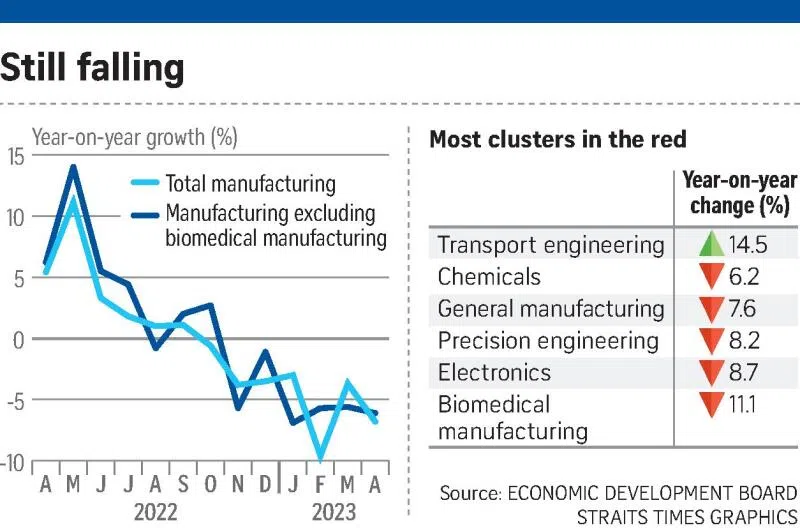Singapore factory output shrinks 6.9% in April, worse than expected
Sign up now: Get ST's newsletters delivered to your inbox

Manufacturing output continued to contract for a seventh straight month, with the slump deepening in April.
PHOTO: ST FILE
Follow topic:
SINGAPORE – Singapore’s manufacturing output continued to contract for a seventh straight month, with the slump deepening in April, raising the risk of the economy slipping into a technical recession.
Factory output fell 6.9 per cent year on year in April, after falling a revised 3.8 per cent in March, according to data released by the Economic Development Board on Friday. The drop was worse than the 4.5 per cent contraction forecast by analysts in a Bloomberg poll.
Excluding volatile biomedical manufacturing, production shrank 6.1 per cent.
April’s gloomy data aligns with the warning by the Ministry of Trade and Industry (MTI) on Thursday that the outlook for Singapore’s economy has weakened,
The linchpin electronics cluster, which accounts for 45 per cent of Singapore’s export-driven manufacturing sector, saw output drop 8.7 per cent in April from a year ago.
Within electronics, the computer peripherals and data storage segment saw output plunge 33.5 per cent. It was followed by other electronic modules and components with an 11.9 per cent fall, while semiconductor production dropped again, dipping by 6.9 per cent.
All other manufacturing clusters saw output shrink year on year, with the exception of transport engineering.
Biomedical manufacturing was the worst performer, with output falling 11.1 per cent, reversing from March’s 8.2 per cent increase.
Within the sector, pharmaceuticals output shrank 14.1 per cent due to a different mix of active drug ingredients being produced compared with a year ago. Medical technology production contracted 7.2 per cent, with lower demand for medical devices from the United States and Europe.
In contrast, the transport engineering sector posted a 14.5 per cent increase, although this was smaller than the 23.5 per cent rise recorded in March.
The sector’s marine and offshore engineering segment expanded 24.2 per cent on greater shipyard activity and increased production of oil and gas field equipment.
The aerospace segment grew 16.1 per cent, with more maintenance, repair and overhaul jobs from commercial airlines on the back of increased global air traffic.
The chemicals sector saw output fall 6.2 per cent year on year in April, while precision engineering suffered an 8.2 per cent drop and general manufacturing shrank by 7.6 per cent.
Maybank Research senior economist Chua Hak Bin said the electronics downturn, often used as a gauge of the business cycle, showed no signs of a turnaround, while the sharp manufacturing contraction in April raised the risk of a technical recession.
ANZ head of Asia research Khoon Goh agreed, but said that the weak data was partly due to its juxtaposition against a very sharp rebound in March.
In addition, April had fewer working days than March and after accounting for that, overall activity was not as weak as the headline number suggested, he said.
DBS Group Research economist Chua Han Teng expects manufacturing output to remain negative for a few more months, with risks tilted to the downside.
“Two areas that we are monitoring are a possible turnaround in the electronics cycle in the second half of this year as the inventory destocking process winds down, and as China’s post-pandemic growth recovery broadens,” he said.
On a brighter note, Mr Goh said there were signs that peak electricity demand was starting to recover in late April and early May, which could suggest a potential improvement in the manufacturing sector if this continued.
Maybank’s Dr Chua expects full-year gross domestic product growth to remain unchanged at 0.8 per cent, which is at the lower end of MTI’s forecast range of 0.5 per cent to 2.5 per cent.
He said the boost from China’s reopening was reviving only tourist arrivals but not the export and manufacturing sectors, and this “may not be enough to drive a significant recovery in the coming quarters”.



